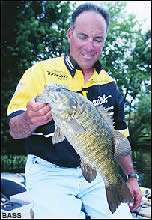
You can't blame Ohioan Frank Scalish for constantly tinkering with fishing lures. Part of the obsession stems from his artistic nature. His sketches of fish and wildlife look real enough to leap off the paper. The other motivation is the stiff competition he faces on the CITGO Bassmaster Tour. He's always searching for a secret weapon to get an edge on the other pros.
Scalish came up with an innovative idea after his friend and fellow Tour angler Rufus Johnson taught him the rudiments of the float & fly. In a nutshell, the float & fly suspends a hook dressed with hair beneath a bobber. It's deadly for suspended bass in cold water, especially on clear, highland lakes, such as Dale Hollow.
It didn't surprise Scalish that coldwater bass are chumps for a fly dangling under a bobber. Over the years, he has taken scads of bass by bouncing and swimming his homemade hair jigs over the bottom. He knew that hair presented bass with a slimmer profile than rubber and silicone skirts, and that certain types of hair undulate with a subtle "breathing" action.
Then it hit him: Why wouldn't a fly catch bass on a drop shot rig? It would be a superfinesse presentation for coldwater bass.
Using his fly tying skills, Scalish made several flies with materials he employs for saltwater streamers. His initial creations never saw the water because Scalish determined that they were too thin. To bulk up the flies, he tied a thick tail section to the hook before tying on the body. This approach gave him the length, bulk and action he was looking for.
Success
Scalish was eager to see bass respond to his new flies, but winter was descending on his northern Ohio home and he wasn't scheduled to fish a tournament in the sunny South for months. Undaunted, Scalish and his young son, Frankie, ventured to a nearby Lake Erie Marina. His bass boat's water temperature gauge read 39 degrees.
"Frankie and I spent the afternoon shaking drop shot flies around boat docks in 10 to 12 feet of water," Scalish says. "By the time we left, we had caught about 60 largemouth that averaged a pound and a half, and 35 crappies."
The Scalish's had so much fun with their drop shot flies, they made plans to return the following weekend. They had to cancel the outing when a thick crust of ice prevented them from launching.
When he fishes tournaments, Scalish now reserves the drop shot fly for late fall and early spring when the water temperature is less than 50 degrees. He concentrates on vertical structures, such as bluffs and sharp drops adjacent to rocky points.
A 7-foot medium action Quarrow graphite spinning rod and 8-pound Silver Thread Fluorocarbon line handles Scalish's drop shot duties. Depending on the depth, wind and current, he anchors his drop shot rigs with a 3/16- to 3/8-ounce drop shot weight. He ties the fly to the line with a Palomar knot and runs the long tag end of the knot down through the hook's eye to make the fly stand straight out, with the hook's point turned up.
The unplastic
Scalish shakes the fly on a semislack line, just as he does when drop shotting a plastic bait. Though the technique is essentially the same, the fly shows bass something entirely different.
"The midsection of the body remains bulky and teardrops to a point at the tail, just like a baitfish," Scalish says. "The hair is always moving, even when your rod is still. It looks like a hovering baitfish flicking its fins."
Scalish also claims that the fly gives off subtle baitfishlike reflections. And when a bass strikes, there is no plastic to ball up and impede the hook set.
"When a bass nabs a fly, it's all hook, baby," Scalish says. "That fish is yours."
Tying the drop shot fly
1. Clamp a straight eye No. 2 or No. 4 Mustad C529 BLN hook in a fly tying vice. Wrap white 3/0 Danville monocord thread around the hook's shank, starting behind the eye and working toward the bend. Then tie white acrylic craft hair to the end of the hook so it extends past the bend about the length of the hook.
2. Wrap the thread back to the hook's eye and tie in six strands of pearl Krystal Flash that run to the end of the tail fibers. Then, tie in white acrylic belly hair (the fly is upside down in the vice).
3. Tie pink hair to the belly and blue hair to the back. Add several strands of silver Krystal Flash to the back, and several strands of fine, shiny Light-Bright Polar Pearl to the belly.
4. Build up the head with black monocord. Wrap red monocord behind the black thread to simulate gills. Paint the eyes with Modelmaster enamel and finish with a coat of Sally Hansen's "Hard as Nails" clear nail polish with nylon.

